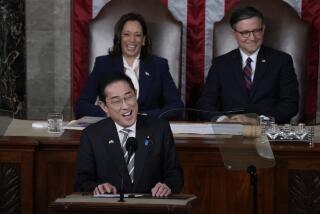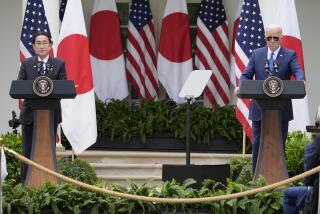New Risks Across the Pacific
- Share via
As it is the world’s second largest economy and principal source of excess global savings, it is important to get Japan right. With yen interest rates so low and funds from Japan cascading into international markets, any major change in the country’s fundamental economic situation, financial balances or management of its regulatory structure would have profound global implications.
With the interest rate cost of yen loans close to zero, ultra-cheap lending from Japan has been central to financing the boom in global bond and equity markets over the past two years. In 1996, U.S. investors were net sellers of their own bond market. All of that selling plus all of the net new issuance of U.S. government debt last year was purchased by foreign investors, a large number from Japan.
After worrying in public for some weeks about frothy markets, America’s central bankers nudged interest rates a smidgen higher last month. In the aftermath, markets fell sharply.
But the real source of worry is Japanese interest rates. Were they to rise any time soon, the effect on global markets would be brutal. The cheap Japanese funding that has been the global market boom would become suddenly much more expensive.
Japanese financial institutions have faced increasingly intense strain in the past few years under the crushing weight of nonperforming assets. In an attempt to neutralize these pressures, the Bank of Japan chopped the funding costs of the banks virtually to zero. These measures have met with some success, as the financial system has been able to make provisions for about 40% of the bad debt. But that leaves still $250 billion in write-offs.
The pressures remain enormous. This month, two of Japan’s largest banks in effect ran out of liquidity. To contain what otherwise could have been a devastating financial chain reaction, a $15-billion emergency package was engineered, with the authorities both “volunteering” some of the healthier banks to step into the breach and mobilizing the resources of the Bank of Japan.
Analysts have seldom been more negative on Japan. Ceaselessly the question is raised: “When will Japan’s recession end?” The market is spooked. Predictions of an accelerating long-term decline are repeated almost mantralike. Corporate leadership in Europe and North America is increasingly focused elsewhere. Investors are in retreat.
Yet even the most cursory examination of Japan’s real economy reveals a sharply different reality. In 1996, Japan had the fastest growth of all the developed economies at 3.6%. The U.S. registered 2.5% and Germany 1.5%. Despite claims that “Detroit is back,” Japan’s auto makers have just concluded the best quarter ever in North America, taking 32.08% of the market for cars and 41.6% for auto parts. With the yen down 50% to 60% from where it was two years ago against virtually all the world’s major trading currencies, and repositioning and aggressively chopping costs, Japan’s major exporters are back building market share around the world.
At the same time, company after company in Japan’s manufacturing sector is announcing record profits. This part of Japan’s economy is probably stronger than ever. In fact, Japan’s nonfinancial companies registered in the last quarter the highest pretax cash flow ever. The interest rate environment, which allows even second- and third-tier firms to raise long-term yen financing at ultra-low levels, is leading to even stronger balance sheets.
Capital investment is growing. Housing starts have been strong for some time. Real wages have continued to increase, and unemployment peaked almost two years ago. Indeed, Japan created new jobs in the past year at a faster pace than did the United States.
But due to the crash of real estate and equity prices, the fast pace of restructuring, the fragility of the banking sector and the talk about the end of lifetime employment, the consumer remains very cautious. The result is that Japan’s households are flush with cash.
It is against this background that Japanese authorities are wagering that in spite of the difficulties of the financial sector, the economy is strong enough to absorb a substantial increase in taxes and social security payments. But that means Japan’s very competitive multinationals will be looking with increasing appetite to growth through exports.
At the same time, as Washington moves to raise interest rates and taxes, America is on course for slower growth. That means the United States also will be looking increasingly to foreign markets for growth.
It is in this complex context of contradictions that the policy debate across the Pacific is about to take a new turn, fraught with uncertainty, risk and global implications.
More to Read
Inside the business of entertainment
The Wide Shot brings you news, analysis and insights on everything from streaming wars to production — and what it all means for the future.
You may occasionally receive promotional content from the Los Angeles Times.










